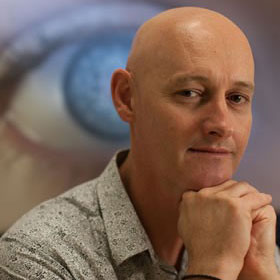Scientia Professor Nigel Lovell is Head of the Graduate School of Biomedical Engineering at UNSW Sydney and co-lead of the Brain Sciences and Translational Neuroscience sub-theme of the UNSW Medicine Neuroscience, Mental Health and Addiction Theme and SPHERE Clinical Academic Group (CAG).
As the only sub-theme co-lead with an engineering background, Scientia Professor Lovell brings a unique perspective to the role and believes analytical and technological approaches to issues in neuroscience, mental health and addiction must address real-world problems.

Name: Nigel Lovell
Position/s: Scientia Professor and Head, Graduate School of Biomedical Engineering (GSBmE)
Theme and CAG position: Co-lead of the Brain Sciences and Translational Neuroscience sub-theme
What are you hoping to achieve in this role?
Many of the most exciting advances in science and medicine in recent times have resulted from interdisciplinary collaborations. Such collaborations are at the very core of what I do as a biomedical engineer, as the essence of the discipline involves applying engineering tools and technologies to solve problems in medicine and biology. However, engineers often design technologies in search of a problem. What I hope to achieve in my role as sub-theme co-lead, is to ensure that the analytical and technological approaches we develop address real-world problems and issues in neuroscience, mental health and addiction.
How has the Neuroscience, Mental Health and Addiction Theme and CAG facilitated new opportunities in research and/or collaboration in the Brain Sciences and Translational Neuroscience sub-theme?
The Theme and CAG has been instrumental in forming interdisciplinary collaborations. I now have half a dozen projects with partners from local health districts, Neuroscience Research Australia (NeuRA), Black Dog Institute, National Drug and Alcohol Research Centre (NDARC) and UNSW Medicine.
For example, in the 2018 round of Neuroscience, Mental Health and Addiction Theme and CAG Collaborative Research Seed Funding, a collaboration between NeuRA, the Graduate School of Biomedical Engineering at UNSW Sydney, and Cardiology at Prince of Wales Hospital, was awarded $40,000. This project, led by Associate Professor Kim Delbaere at NeuRA, will trial a program called StandingTall-Cardio. This scalable intervention uses mobile technology to enhance healthy ageing and reduce fall risk in people with intermittent peripheral arterial disease (PAD).
PAD is a significant public health problem and major barrier to healthy ageing, with prevalence rates of about 40% in older people. PAD patients typically experience intermittent claudication (IC) – an intense cramping leg pain triggered by exercise – as well as poor mental health, frailty and fall-related injuries. This causes functional decline, high health service use and loss of independence. Of all cardiovascular disease patients, PAD patients have the highest rates of vascular intervention, stroke and cardiovascular death.
StandingTall-Cardio is the first scalable self-management program for PAD delivered through mobile technology. Specific to PAD, StandingTall-Cardio includes evidence-based standing balance exercises, pain management and interval walking components.
This collaboration between clinicians, engineers and scientists was made possible through the Theme and CAG. Recently the collaborators, in a project led by Dr Matthew Brodie from NeuRA, were successful in being awarded $500,000 in funding from an international funding body for a variant of this program called StandingTall-Parkinsons to help manage gait freezing in Parkinson’s patients.
In another exciting project in the gene electrotherapy area, my group at GSBmE has teamed up with Scientia Professor Gary Housley’s Translational Neuroscience Facility to model and design neural electrodes for neural augmentation in the cochlear and for potential DNA vaccine and immunotherapy treatments.
What do you see as the emerging areas of research in the sub-theme?
As the only sub-theme co-lead with an engineering background, I no doubt have a different perspective on what emergent areas exist. In a grand vision, I would see that technology becomes more and more pervasive. Remote monitoring technologies, including smartphone apps, wearable and implantable devices, will provide personalised management of a variety of conditions from chronic disease and wellness, to mental health and obesity, to automated falls identification and prevention. At GSBmE we have a group of researchers and programmers who are developing wearable technologies and smartphone apps that adhere to privacy and security provisions and have the potential to be regulatory-approved medical devices. I would invite clinical collaborators in the sub-theme and wider Theme and CAG to engage with us in exploring how we could use such technologies in their own clinical domains for the benefit of their patients.

